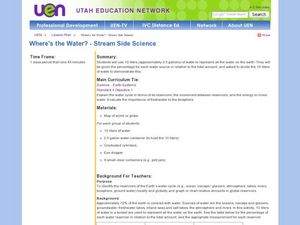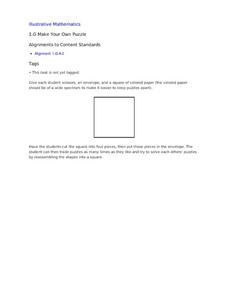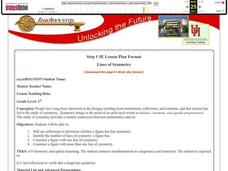Curated OER
Where's the Water? Stream Side Science
After a whole-class discussion of water reservoirs, ten liters of water are given to each lab group to represent Earth's total amount of water. They divide the water into smaller containers, each representing one of those reservoirs. The...
Curated OER
As the Wheel Turns
This is not your typical Ferris wheel problem. In this exercise, your class will combine their knowledge of sinusoidal functions as well as linear motion to come up with parametric equations that model the position of a point on the edge...
Curated OER
Egyptian Fractions
You don't have to be an ancient Egyptian to decipher fractions in this activity that focuses on adding fractions with unlike denominators and developing fraction number sense. Egyptians represented fractions differently than we do. They...
Illustrative Mathematics
Banana Bread
Show your future bakers how to choose the right baking pan by calculating the volume of a pan. The resource compares two pans, one with decimal edge lengths and is too small for the recipe and one that may work. Your number crunchers are...
Illustrative Mathematics
Make Your Own Puzzle
Puzzling over what geometry activity to teach next? Look no further. This simple activity teaches young mathematicians how shapes can be decomposed into smaller figures, and how smaller figures can be assembled into larger shapes. To...
Penn Museum
Penn Museum: China Gallery
Invite your learners to take a closer look at the art and mathematical function of dome buildings as designed by the ancient Romans. In the next segment of this attractive instructional activity set, your young historians will then learn...
NASA
Applying Newton’s Laws
Newton's Laws get the rocket to work, but do they serve any other functions? A six-page resource classifies rockets by the type of propellant they use. It then describes applications of Newton's Laws of Motion, both in the ability to...
NASA
NASA Engineering Design Challenges - Spacecraft Structures
What kind of design challenges are there in building structures to support rocket engines? The unit takes design teams through the process of building the lightest possible thrust support structure that can withstand the necessary forces...
West Contra Costa Unified School District
Talking About Distance, Rate and Time
Connect the tortoise and the hare fable to mathematics. Learners first identify key terms related to distance, rate, and time. They then solve distance/rate/time problems using different representations.
Bowland
Magic Sum Puzzle
Learners discover the magic in mathematics as they solve numerical puzzles involving magic sums. They then make a conjecture as to why no additional examples are possible based on an analysis of the puzzles.
Statistics Education Web
Are Female Hurricanes Deadlier than Male Hurricanes?
The battle of the sexes? Scholars first examine data on hurricane-related deaths and create graphical displays. They then use the data and displays to consider whether hurricanes with female names result in more deaths than hurricanes...
Virginia Department of Education
Inductive and Deductive Reasoning
Introduce pupils to the two types of reasoning, inductive and deductive. Classmates work in pairs or small groups to learn the difference between the two and apply these reasonings to develop valid conclusions.
Space Awareness
Oceans on the Rise
Temperature rises and land disappears! Through a lab exploration, learners understand the effect of temperature increase on water similar to the effect of global warming on our oceans. As they heat the water in a flask, they measure the...
American Statistical Association
Chunk it!
Chunking information helps you remember that information longer. A hands-on activity tests this theory by having learners collect and analyze their own data. Following their conclusions, they conduct randomization simulations to test...
Purdue University
Design of a Door Alarm
How does electricity work? Budding scientists explore the concepts of electrical currents and open and closed circuits with class discussion and a hands-on activity using a battery to turn on a light bulb. Learners also make predictions...
Rice University
Intermediate Algebra
Algebra concepts are all wrapped up in one nice bow. The resource combines all the concepts typically found in Algebra I and Algebra II courses in one eBook. The topics covered begin with solving linear equations and move to linear...
Curated OER
Justifying Mathematical Conjectures
Sixth graders, in groups, explain why they think something. This requires students to listen to and respond to each other. In this particular lesson, 6th graders explain to their classmates when one can or cannot construct a specific...
Curated OER
Duplicating Segments and Angles
Tenth graders investigate geometric construction. In this geometry lesson, 10th graders explore the procedure for copying an angle and a segment. The lesson emphasizes the difference between a sketch, a drawing, and a construction and...
Curated OER
Recognizing Patterns
Students explore the concept of patterns. In this patterns instructional activity, students use applets to manipulate tessellations. Students predict the next number in a sequence by recognizing patterns.
Curated OER
Negative Magic Squares
Magic squares are interesting objects in both mathematics proper and in recreational mathematics. So they are objects that children should have heard about and experienced. The problems in this sequence give students the opportunity to...
Curated OER
A Look Back
Learners explore the contributions of women in the field of mathematics. In this middle or high school mathematics lesson, students use their reading and listening skills to examine lesson targeted at the stereotype of women having...
Curated OER
Building a Bridge
Third graders discover architecture and functionality by constructing a bridge. In this bridge engineering lesson, 3rd graders utilize cardboard, straws, towel tubes and plastic bottles to create a model bridge similar to ones seen in...
Curated OER
Building a Native American Home
First graders explore different types of Native American shelters. For this Native American homes lesson, 1st graders compare the shapes of shelters used by Native Americans. They build a home using the program "Community Construction...
Curated OER
Lines of Symmetry
Fourth graders identify lines of symmetry using reflections and then construct figures that have one or more lines of symmetry. In this symmetry lesson plan, 4th graders use sets of shapes, pattern blocks, a mirror, and more.

























